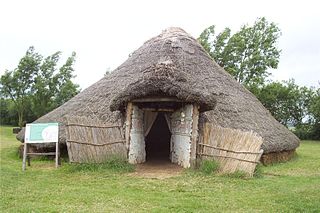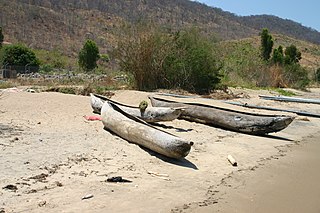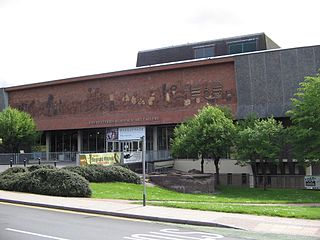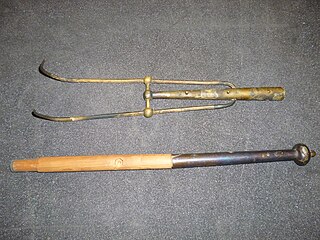
Flag Fen, east of Peterborough, England, is a Bronze Age site which was constructed about 3500 years ago and consists of more than 60,000 timbers arranged in five very long rows, creating a wooden causeway across the wet fenland. Part-way across the structure a small island was formed. Items associated with it have led scholars to conclude that the island was of religious significance. Archaeological work began in 1982 at the site, which is located 800 m east of Fengate. Flag Fen is now part of the Greater Fens Museum Partnership. A visitor centre has been constructed on site and some areas have been reconstructed, including a typical Iron Age roundhouse dwelling.

A dugout canoe or simply dugout is a boat made from a hollowed-out tree. Other names for this type of boat are logboat and monoxylon. Monoxylon (μονόξυλον) is Greek – mono- (single) + ξύλον xylon (tree) – and is mostly used in classic Greek texts. In German, they are called Einbaum. Some, but not all, pirogues are also constructed in this manner.

Shardlow is a village in Derbyshire, England about 6 miles (9.7 km) southeast of Derby and 11 miles (18 km) southwest of Nottingham. Part of the civil parish of Shardlow and Great Wilne, and the district of South Derbyshire, it is also very close to the border with Leicestershire, defined by the route of the River Trent which passes close to the south. Just across the Trent is the Castle Donington parish of North West Leicestershire.

The Potteries Museum & Art Gallery is in Bethesda Street, Hanley, one of the six towns of Stoke-on-Trent in Staffordshire. Admission is free.

The Mold gold cape is a ceremonial cape of solid sheet-gold from Wales dating from about 1900–1600 BCE in the British Bronze Age. It was found at Bryn yr Ellyllon burial mound near Mold, Flintshire in 1833.

The Salisbury Museum is a museum in Salisbury, Wiltshire, England. It houses one of the best collections relating to Stonehenge and local archaeology.

King's Mill is the traditional crossing point of the River Trent between Castle Donington in Leicestershire and Weston-on-Trent in Derbyshire. The Mill was the farthest point that traffic from the Humber could progress. A lock was installed here to make the river navigable but the business eventually collapsed due to competition with the Trent and Mersey Canal. The mill was used for grinding flints for the pottery industry, locally mined plaster, and dyestuffs when it was owned by Samuel Lloyd of the Birmingham banking company.

The Staffordshire Hoard is the largest hoard of Anglo-Saxon gold and silver metalwork yet found. It consists of almost 4,600 items and metal fragments, amounting to a total of 5.1 kg (11 lb) of gold, 1.4 kg (3 lb) of silver and some 3,500 pieces of garnet cloisonné jewellery. It is described by the historian Cat Jarman as "possibly the finest collection of early medieval artefacts ever discovered".

The Mercian Trail is the name given to a group of museums and historical sites in the West Midlands of England that will be used to display objects from the Staffordshire Hoard. The trail is organised by a partnership of Lichfield District, Tamworth Borough Council, Staffordshire County Council, Stoke-on-Trent City Council and Birmingham City Council, and features the following locations:

The Little Thetford flesh-hook is a late Bronze-Age artefact discovered in 1929 in Little Thetford, near Ely, Cambridgeshire, England. A flesh-hook is a metal hook with a long handle used to pull meat out of a pot or hides out of tan-pits. This particular find is one of 32 other such archaeologically significant finds, scatters, and excavations within 1 square mile (2.6 km2) of Little Thetford.

The National Museum of Ireland – Archaeology is a branch of the National Museum of Ireland located on Kildare Street in Dublin, Ireland, that specialises in Irish and other antiquities dating from the Stone Age to the Late Middle Ages.

Catton is a civil parish within the South Derbyshire district, which is in the county of Derbyshire, England. Overwhelmingly rural, its population is reported alongside the adjacent parish of Coton in the Elms for a total of 896 residents in 2011. The parish is 100 miles (160 km) north west of London, 15 miles (24 km) south west of the county city of Derby, and 5 miles (8.0 km) south west of the nearest market town of Burton upon Trent. Being on the edge of the county border, it shares a boundary with the parishes of Coton in the Elms, Lullington and Walton upon Trent in Derbyshire, as well as Barton-under-Needwood, Edingale and Wychnor in Staffordshire. Catton Hall, a historic country house and the surrounding Catton Park are notable for hosting several annual events.
Saruq Al Hadid is an archaeological site in Dubai, United Arab Emirates (UAE), and stands as one of the most important and enigmatic historical sites in the country. Findings from the site are displayed in a museum with the same name in the city of Dubai. The site was originally discovered by the ruler of Dubai, Sheikh Mohammed bin Rashid Al Maktoum, while flying his helicopter across the desert.

State Museum, Lucknow is a prominent museum located in the capital city of Uttar Pradesh, India. The museum is currently located in the Nawab Wajid Ali Shah Zoological Gardens, Banarasi Bagh, Lucknow. The museum was established in 1863 from the collection of Colonel Saunders Alexius Abbott, and was given the status of ‘Provincial Museum’ before being renamed the ‘State Museum’ in 1950.

The Aymestrey burial was a beaker cist at Aymestrey, Herefordshire, England. The remains and objects are now in a recreated cist, at Leominster Museum.

Heathery Burn Cave is a cave near Stanhope, County Durham, England, in which a large collection of Late Bronze Age weapons and tools was discovered and excavated between 1859 and 1872.

Part of a Bronze Age settlement was uncovered at Must Farm quarry, at Whittlesey, near Peterborough, in Cambridgeshire, England. The site has been described as "Britain's Pompeii" due to its relatively good condition, including the "best-preserved Bronze Age dwellings ever found" there, which all appear to have been abandoned suddenly following a catastrophic fire. Research now suggests that the site was less than one year old at the time of destruction.

The Hull and East Riding Museum of Archaeology is located in the Museums Quarter of the Old Town in Kingston upon Hull, England. It dates back to 1925 as the Museum of Commerce and Industry in a former Customs House but acquired its present name in 1989 with a major refurbishment and new entrance, with the transport section moving to a separate museum. It displays items from prehistoric to medieval in the area, many of them in life-size tableaux or reconstructions of rooms and buildings.

The Havering hoard is a hoard of 453 late Bronze-age artefacts found at a site overlooking the River Thames in Rainham, London, in 2018. It is the largest bronze-age hoard to be found in London and the third-largest in the United Kingdom. The discovery was made during an archaeological investigation of the site prior to its use for gravel extraction. The finds included weapons, tools and ingots, but only a small quantity of jewellery. It was unusual in being buried in four separate locations; most bronze-age hoards previously excavated have been concentrated in a single location. Some of the items are from continental Europe, demonstrating links with that region. Several proposals have been put forward for the origin of the hoard, which include a collection of goods for recycling, an attempt by a single individual to control the bronze trade in the area or the large-scale abandonment of bronze goods at the start of the Iron Age. The artefacts are currently on exhibition at the Museum of London Docklands, after which they will be on display at the Havering Museum in Romford.

The Appleby logboat is a Bronze Age logboat, found during dredging of the old River Acholme near Appleby, North Lincolnshire, England in 1943. It dates to the period 1500–1300 BC. It is one of two prehistoric dug-out boat found in the Ancholme, the other being found near Brigg in 1886. Both of these boats contain evidence of repairs in the form of sewing of lashing techniques: splits in the wood had been repaired using birch plants held in place by oak wedges.




















